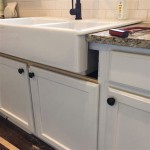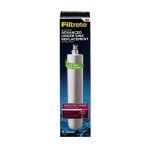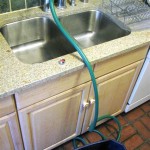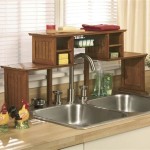How To Fix a Clogged Drain In Kitchen Sink
A clogged kitchen sink drain represents a common household problem, often occurring due to the accumulation of food particles, grease, hair, and other debris within the drainpipe system. Addressing a clogged drain promptly is crucial to prevent further complications such as unpleasant odors, slow drainage, and potential damage to plumbing fixtures. This article provides a comprehensive guide to various methods for resolving kitchen sink clogs, ranging from simple DIY techniques to more advanced approaches.
Before initiating any repair efforts, it is essential to identify the severity of the clog. Slow drainage typically indicates a partial blockage, while standing water in the sink signifies a complete obstruction. Gathering necessary tools and materials beforehand streamlines the unclogging process. Common tools include a plunger, drain snake (also known as an auger), baking soda, vinegar, hot water, a bucket, and rubber gloves. Ensuring adequate ventilation and wearing appropriate personal protective equipment, such as gloves, protects against potential irritants or bacteria present in the drain.
Using Hot Water
The simplest method for resolving minor clogs involves flushing the drain with hot water. This approach is particularly effective for dissolving grease buildup. Fill a kettle or pot with hot water and allow it to reach a near-boiling temperature. Carefully pour the hot water down the drain in stages, pausing intermittently to allow the water to work its way through the clog. Avoid using boiling water if the sink or pipes are made of PVC, as excessive heat can damage these materials. After pouring the hot water, observe whether the water drains more quickly. If the clog persists, proceed to other methods.
It is important to exercise caution when using hot water, as burns can occur. Wear appropriate protective gear, such as rubber gloves, and handle the hot water with care. Avoid splashing water onto surrounding surfaces. If the first attempt does not clear the clog, repeat the process a few times. However, if the drain remains clogged after multiple attempts, it indicates a more significant obstruction requiring a different approach. Utilizing a combination of hot water with other techniques, such as using a plunger, can sometimes enhance the effectiveness of this method.
Employing a Plunger
A plunger is a widely used and effective tool for dislodging clogs in kitchen sinks. The force of suction created by the plunger can break up obstructions and allow water to flow freely. First, ensure there is sufficient water in the sink to cover the cup of the plunger. If necessary, add water to create a seal around the drain opening. Apply petroleum jelly to the rim of the plunger to enhance the seal and improve suction. Place the plunger over the drain opening, ensuring a tight seal.
Grip the plunger handle firmly and begin plunging vigorously up and down, maintaining the seal throughout the process. Avoid lifting the plunger completely off the drain opening during each stroke. Continue plunging for several minutes, then remove the plunger to check if the water is draining. If the water drains, flush the drain with hot water to ensure the clog is completely cleared. If the clog persists, repeat the plunging process several times. For double kitchen sinks, seal the second drain opening with a wet cloth or stopper to maximize the suction power of the plunger on the clogged side.
Effective plunging requires a consistent and forceful up-and-down motion. If the sink is only partially filled with water, the plunger may not create sufficient suction to dislodge the clog. Ensuring a proper seal between the plunger and the drain opening is essential for generating the necessary force. If the plunger fails to clear the clog after multiple attempts, consider using a different method, such as a drain snake.
Baking Soda and Vinegar Solution
A combination of baking soda and vinegar constitutes a natural and effective solution for unclogging kitchen sink drains. This method utilizes a chemical reaction to break down grease and debris. Begin by pouring approximately one cup of baking soda down the drain, followed by one cup of white vinegar. The mixture will begin to fizz and bubble as the baking soda reacts with the vinegar. Allow the mixture to sit in the drain for at least 30 minutes, or preferably overnight, to maximize its effectiveness.
After the waiting period, flush the drain with hot water. The hot water helps to wash away any remaining residue and dissolve the loosened clog. Observe whether the water drains more quickly. If the clog persists, repeat the baking soda and vinegar treatment. This method is typically effective for minor to moderate clogs. For stubborn clogs, a variation of this method involves using boiling water after the baking soda and vinegar treatment. This can further enhance the dissolving power of the solution.
The baking soda and vinegar method is a safe and environmentally friendly alternative to harsh chemical drain cleaners. However, it is important to avoid using this method in conjunction with chemical drain cleaners, as the combination can create hazardous fumes. Properly ventilate the area during and after the treatment. If the drain remains clogged after multiple attempts with baking soda and vinegar, more aggressive measures, such as using a drain snake, may be necessary.
Utilizing a Drain Snake (Auger)
A drain snake, also known as an auger, represents a flexible tool designed to physically break up and remove clogs from drainpipes. This method is particularly effective for dislodging stubborn clogs that are resistant to other techniques. To use a drain snake, first, locate the drainpipe opening. This may be accessible directly within the sink drain or indirectly by removing the P-trap underneath the sink.
Carefully insert the drain snake into the drainpipe, feeding it through the opening until resistance is encountered. This resistance indicates the location of the clog. Rotate the handle of the drain snake to break up or grab the clog. Continue feeding the snake into the drainpipe until the clog is fully dislodged. Once the clog is broken up, slowly retract the drain snake, pulling out any debris that adheres to the snake. Dispose of the debris properly.
After removing the drain snake, flush the drain with hot water to ensure the clog is completely cleared. Repeat the process if necessary. Using a drain snake requires patience and careful handling to avoid damaging the drainpipes. Avoid forcing the snake into the drainpipe, as this can cause it to become stuck or damage the pipe. If the drain snake encounters significant resistance and cannot be advanced further, it may indicate a more serious plumbing issue requiring professional assistance.
Examining and Cleaning the P-Trap
The P-trap, a curved section of pipe located beneath the kitchen sink, is designed to trap debris and prevent sewer gases from entering the home. This section of the plumbing system is a common location for clogs to form. To inspect and clean the P-trap, first, place a bucket or container beneath the P-trap to catch any water that may spill out during disassembly. Carefully loosen the slip nuts that connect the P-trap to the drainpipes. Use pliers if necessary to loosen stubborn nuts, but avoid overtightening, which can damage the pipes.
Once the slip nuts are loosened, carefully remove the P-trap from the drainpipes. Empty the contents of the P-trap into the bucket. Inspect the P-trap for any accumulated debris, such as food particles, grease, or hair. Remove any visible debris by hand or with a tool. Rinse the P-trap thoroughly with water to ensure it is completely clean. After cleaning the P-trap, reassemble it by connecting it back to the drainpipes and tightening the slip nuts. Ensure the slip nuts are snug but not overtightened.
After reassembling the P-trap, run water into the sink to check for leaks. If leaks are detected, tighten the slip nuts further. If leaks persist, the slip nuts or the P-trap itself may need to be replaced. Regular cleaning of the P-trap can help prevent clogs from forming in the first place. Consider cleaning the P-trap every few months as part of routine kitchen maintenance. When disassembling the P-trap, it is important to remember the order in which the components are connected. Taking a photograph before disassembly can serve as a helpful reference during reassembly.
Preventative Measures
Preventing clogs in the kitchen sink drain is often more effective than resolving them after they occur. Several preventative measures can significantly reduce the likelihood of clogs forming. One key practice involves avoiding the disposal of grease down the drain. Grease solidifies as it cools, leading to buildup within the drainpipes. Instead, collect grease in a container and dispose of it in the trash.
Another important preventative measure involves using a drain strainer or screen to catch food particles and other debris before they enter the drain. Empty the strainer regularly to prevent it from becoming clogged. Avoid disposing of large food scraps down the drain. Instead, dispose of them in the trash or compost them. Run hot water down the drain regularly, especially after washing dishes, to help flush away any grease or debris that may have accumulated.
Periodically flushing the drain with a baking soda and vinegar solution can also help prevent clogs from forming. Furthermore, avoid pouring coffee grounds down the drain, as they can accumulate and cause blockages. By implementing these preventative measures, one can significantly reduce the frequency of kitchen sink clogs and maintain a smoothly functioning plumbing system. Regular maintenance and careful disposal practices contribute to the longevity and efficiency of the kitchen sink drain.

How To Unclog A Kitchen Sink Drain

How To Unclog A Sink The Experts Simple Steps Drain

How To Unblock A Kitchen Sink 7 Methods Qs

How To Unclog A Kitchen Sink Drain By Home Repair Tutor

How To Unclog A Kitchen Sink Drain

How To Unclog A Sink Herrmann Services

Slow Sink Drain Kitchen Not The Trap Youtube

How To Unclog A Kitchen Sink Family Handyman

How To Clean And Unclog A Kitchen Sink Drain Diy Family Handyman

How To Unclog A Double Sink Clumsy Crafter







